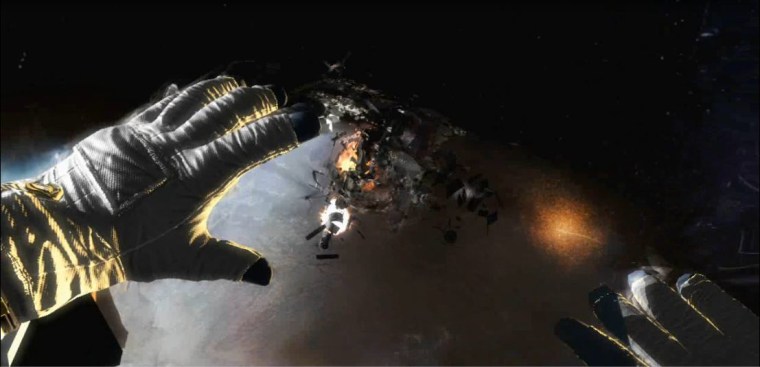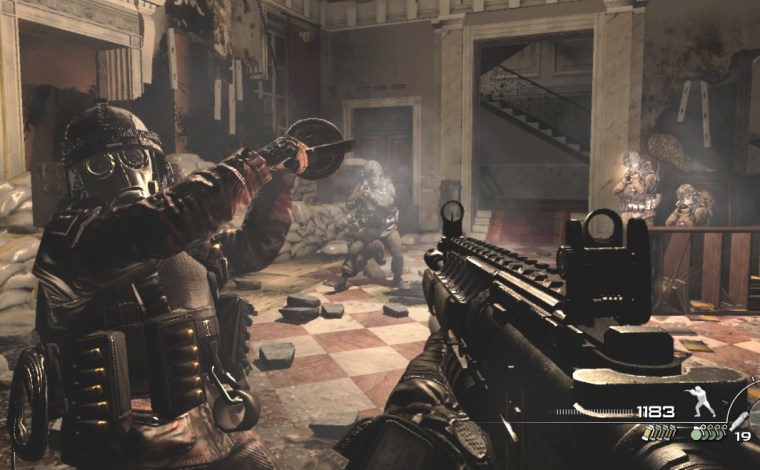SPOILER WARNING: This column talks about some specific story moments within “Modern Warfare 2,” though it does not reveal major plot points.
There’s a scene in “Call of Duty: Modern Warfare 2” that has stuck with me more than any other scene in the new game from Infinity Ward. And it’s not the scene you think it is.
In this one, my military buddy and I are desperate to stop a war-mongering madman. As I approach his hideout in the caves of Afghanistan, I silently rappel down the side of a cliff and hover for a moment above two armed guards protecting the entrance. Then I quickly grab the guard below me, cover his mouth with my hand so he won’t scream, and sink my knife into his belly.
As the guard bleeds to death, he looks directly into my eyes for a long moment ... until, at last, the life fades out of his own eyes.
It’s a brief moment in an epic, action-packed game, but it’s an intimate, affective one made even more so because “Modern Warfare 2” is a game you play from the first-person perspective. I see everything on the screen as though I were actually doing the killing myself, as though I was a soldier and there was a man breathing his last breaths in my arms.
One of the most powerful things about modern video games is the way they tell stories by making the player feel like they are right there in the thick of the plot, living a life they would otherwise never live and doing things they would otherwise never do. And first-person games in particular — those games you play as though you’re looking directly through the eyes of the protagonist — offer an especially potent form of narrative.
Infinity Ward is today’s champion of that perspective. With its award-winning “Call of Duty” franchise, the development company has been telling war stories by putting gamers into the boots of battle-hardened soldiers for six years now.
From the first “Call of Duty” to the first “Modern Warfare,” players have dodged bullets on historic World War II battlefields, and they’ve jumped into the heat of today’s conflict zones from the Middle East to the former Soviet Union. And throughout these games, Infinity Ward has shown that in both the big bombastic battlefield moments it designs as well as in the small, personal moments, it knows how to leverage that first-person perspective in an exceptionally gripping manner.
With their latest game, Infinity Ward reminds us once again that the first-person perspective can be a powerful storytelling tool in a smart game developer’s hands, one that can pluck at players’ emotions like no other. But while “Modern Warfare 2” is an example of a game that uses this most-intimate of perspectives extremely well ... it’s also an example of a game that does it very poorly.
I see what you see
“Modern Warfare 2” takes players from the slums of Rio to the caverns of Afghanistan as it weaves a tale of a world falling into war. This action-filled yarn has you trying to stop a bloodthirsty terrorist, trying to defend American soil and, ultimately, trying to stop the entire globe from tearing itself apart at the seams.
As in previous “Call of Duty” games, the single-player campaign lets players live out this adventure from the perspective of several characters, each involved in a different aspect of the conflict.

As war stories go, it’s not the subtlest thing I’ve seen. As msnbc.com reporter , “Modern Warfare 2” “has all the pacing of a six-hour movie trailer.” And yet, this tale is filled with plenty of intrigue, surprises and even a thoughtful exploration of what the extremists found in all quarters of a conflict can cost humanity.
It certainly delivers the immersive wartime experience that many players are seeking with its big scenes — especially the battle scenes that take place on American soil. Seeing a suburban Virginia neighborhood under siege and filled with gunfire is exceptionally gripping.
But where “Modern Warfare 2” succeeds most — and where Infinity Ward deserves the most praise — is in its smaller moments. The scene I mentioned at the beginning of this column stuck with me because of the intimacy of it. Like all first-person war games, “Modern Warfare 2” spends a lot of time asking me to gun down waves of faceless enemies. But the game had the most impact when it slowed down for a moment and showed me the result of my actions up close and personal: A man’s death. At my hands.
In another scene, I found myself suddenly floating in outer space, literally watching the world go by through the eyes of a member of the International Space Station. For a few moments I was weightless, everything peaceful with Earth’s problems at a safe distance below. But as things go horribly awry on the ground, I was quickly and violently reminded that there really is no escape from the problems that plague our planet.
And then there’s one of the most elegantly heart-wrenching scenes of the game: You suddenly find yourself in an underground bunker, confused, not sure where you’re at, the sounds of panic echoing from a distant radio. As you wander the grim tunnels, you discover some of your fellow soldiers scattered about — injured, miserable, dying. Body bags line the floor.
I didn’t know what I was supposed to do in this moment. And then I stumbled out of the bunker, to the surface, to discover Washington, D.C., a hellish landscape, lain to waste.
Pulling the trigger
The great thing about the opening of this mission was the way it made the true cost of war just a little bit more real (or as real as it can be from the digital distance of a video game). It was a bloody, lonely, disorienting scene. There was nothing to shoot at, no points to be scored — only despair and carnage. In those few moments, there was nothing fun about the game.
And that brings me to the game’s now-infamous airport massacre scene. During this mission — which can be skipped if players choose — you find yourself in the shoes of a CIA spy who has infiltrated a terrorist group and must now walk with them through an airport as they (and potentially you) gun down crowds of innocent civilians. As bullets spray, terrified people run, cower, scream and bleed. The slaughter is massive and unstoppable.
When the scene was first leaked a few weeks ago to cries of protest, representatives of publisher Activision said the scene was “designed to evoke the atrocities of terrorism.” And many critics and journalists familiar with games (myself included) hoped that once the rest of the game was revealed, we would find that the scene had artfully challenged players to experience and to examine the horrifying nature of modern war in a new way.
But having played through the entire game, I can’t say that’s the case.
Yes, some have denounced this scene for its extreme violence, saying that it’s a gut-wrenching, horrific experience and that such an experience doesn’t belong in a game. But I argue that this is the only place that the scene succeeds.
It is a horrific scene and it should wrench at your guts when you play it. After all, real war is far more horrific and war games — especially ones that aspire to some level of “realism” — should make players feel that horror on some level. And with the first-person perspective at developers’ fingertips, games have the potential make us see this horror and experience it more powerfully than any other entertainment medium available to us.
But in this particular case, the terrorist massacre scene is so badly realized within the larger story that it comes off as little more than a ploy by the developers to shock. For starters, it’s ham-fistedly introduced, taking place right after a snowmobile chase that borders on James Bond zanyness. Talk about not setting the right tone. Meanwhile, there’s little to no setup to this scene to help the player feel the terrible weight of the decision your character is about to make.
Gamers frequently bemoan the fact that video games are vilified for their violence while no one raises an eyebrow as movies splatter the silver screen with gore. But if this particular scene were to take place in a war film, you can bet it would be a crescendo moment given careful placement and pacing so that we would fully see the awfulness of what the character is faced with: Will he stop the terrorists from committing this mass slaughter, or will he let it happen as he continues with his charade for the greater good of mankind? Will he refuse to shoot innocents and thus risk being discovered, or will he kill these civilians to save himself and possibly the world?
In “Modern Warfare 2,” all of this is ever so lightly touched on as a gun is put in your hands and you are pointed at crowds of civilians. There is no real chance to think, no chance to consider what it all means. Pull the trigger. Or don’t. Play the scene. Or don’t. Ultimately, it doesn’t even matter. But if Infinity Ward is going to include a scene like this, then it should have mattered very much.
In the end, I didn’t find the airport scene offensive. I know that this is just fiction and that those aren’t real people. I believe that adult games can and should explore difficult adult topics, even if they sometimes fail. Nonetheless, the scene is poor storytelling and it’s a manipulative use of the first-person perspective in the worst way. And coming from a developer who often masterfully uses this perspective to tell its tales, it is especially disappointing to see.
I expected so much better.
Winda Benedetti can be found tweeting from the first-person perspective on Twitter.
